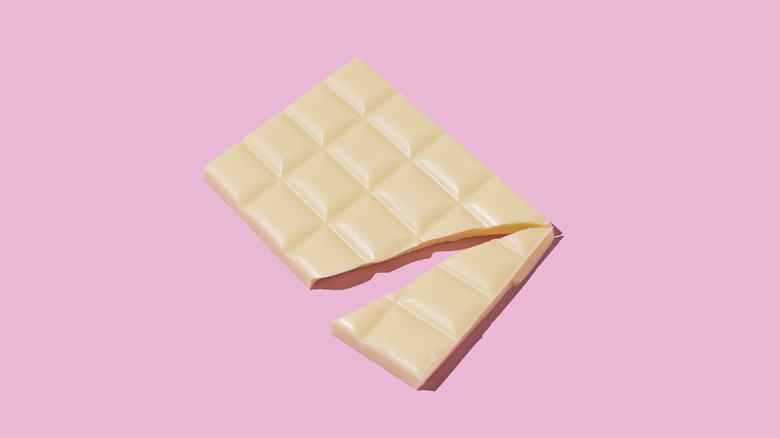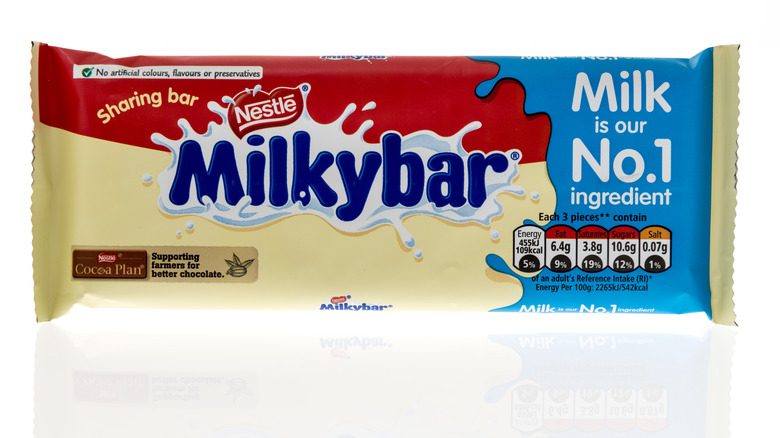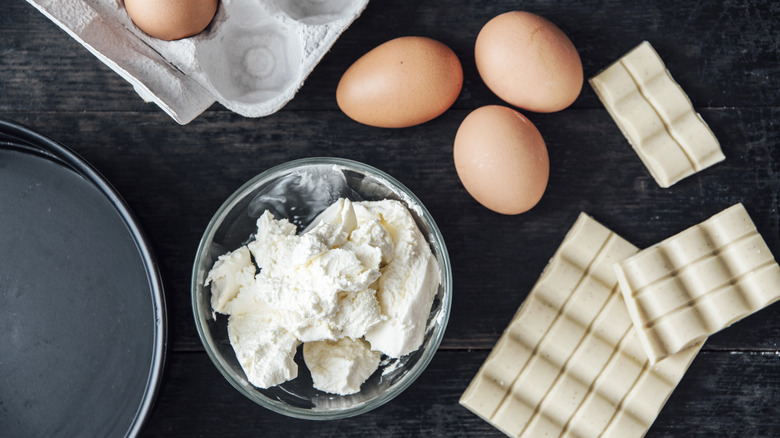If White Chocolate Isn't Really Chocolate, Then What Is It?
Although there are some who may refute the idea, white chocolate is not actually chocolate at all. At least not technically, since white chocolate is made with cocoa butter, milk products, and sugar — but not with the cocoa solids that are essential for a food to be classified as chocolate.
Traditionally, chocolate is made from cocoa beans, which consist of two main components. There are the cacao nibs, which supply the rich flavor, and the cocoa butter, which supplies the creaminess. After roasting and fermenting, the cocoa beans are ground into a paste. This mash is called chocolate liquor, and it contains both cocoa butter and cocoa solids.
At this stage, the production of dark, milk or white chocolate branches out in different directions. The addition of sugar only results in dark chocolate. The addition of both milk and sugar results in milk chocolate. However, to make white chocolate, the cocoa butter is separated from the cocoa solids. Milk products and sugar are added to the cocoa butter, and voilá, white chocolate is born. Cocoa butter is a pale ivory color, so with the addition of milk products, the snowy color is a natural effect.
The history of white chocolate
Nestlé is widely credited as the first to commercially produce white chocolate in Switzerland in the 1930s. A few earlier recipes can be found in cookbooks or pharmacist books labeled "white chocolate," but none of them include the ingredients or method that would lead to our modern understanding of the treat.
The story goes that the discovery of the confection was actually an accident. Nestlé had been attempting to create a dietary supplement for children — a mineral-enriched powdered milk called Nestrovit. They thought the milk would be more attractive to kids in a solid bar form, and they mixed it with cocoa butter to solidify it. Thus, the first white chocolate bar was created. By 1936, Nestlé released their first candy bar of the prototype, called the Milkybar.
Several white chocolate creations followed as the new style of sweet gained popularity in the 1900s. Hershey created their Cookies 'N' Cream bar in 1994, made with white chocolate and chocolate cookie pieces, that would go on to be an enduring classic. The Cadbury Dream was released in 2001 in England. In subsequent years, white chocolate developed a bit of a bad reputation for containing disproportionate amounts of sweeteners and fillers, and very little actual cocoa butter product. In 2002, the FDA officially required that white chocolate must contain a minimum of 20% cocoa butter to rightfully use the term.
The best ways to use white chocolate
White chocolate typically has a mild, sweet flavor and a rich, creamy consistency. As such, it is best used to complement another top flavor note in recipes. For example, white chocolate pairs beautifully with matcha. In this recipe for matcha white chocolate bark, the sweetness from the white chocolate balances out the earthiness of the matcha.
Fruit, such as strawberries and raspberries, bring a fresh tartness to white chocolate desserts, too. For example, the sweet treat is a great addition to strawberry cheesecake, as all of that cocoa butter adds to the velvety smooth mouthfeel of the dish, or a raspberry-poached apples with fennel cream dish that highlights the complex symphony of flavors.
And whereas chocolate fudge relies on the rich taste from dark chocolate, a white chocolate-based fudge leaves room to play with other flavors. This minty mojito fudge recipe is a perfect example. White chocolate also pairs well with its dark or milk chocolate brethren, such as the beloved Starbucks tuxedo mocha.



